Where should I keep a fire extinguisher in my home?
Don’t mount it too close to where a fire is likely to occur. For example, don’t keep it next to the stove. A good place is at the top of the... More »
In this second segment in our 3-part series, we’re going to focus on two key areas in the basement that are prone to leaking air. First, we’ll seal up those leaky ducts that carry conditioned air throughout your home. Then, we’ll address the rim joists cavities that are notorious for leaking air.
In the first segment in our Home Weatherization series we focused on stopping air leaks around windows and doors, as well as penetrations through the exterior walls of your home. Today we’re down in the basement to focus on the common air leaks that you may not have considered, including leaky ductwork and gaps in your home’s rim joist. These are the common subterranean culprits that can rob your home of being energy efficient.
In this second segment in our 3-part series, we’re going to focus on two key areas in the basement that are prone to leaking air. First, we’ll seal up those leaky ducts that carry conditioned air throughout your home. Then, we’ll address the rim joists cavities that are notorious for leaking air. So Let’s get started.
In many basements like this one, ductwork runs from the heater or air conditioning unit up through wall cavities in the first floor to different termination points throughout the house. Part of the problem is that over time, the joints in a home’s duct system loosen, and form gaps that can leak air. It’s a problem that’s hard to spot when the ductwork is covered with drywall, or in our case, an old drop ceiling. At least we can still access it somewhat easily.
One of the biggest misconceptions in the world of hardware is related to the name of a product we’re all familiar with ... duct tape. The problem is while it’s used to fix or seal up nearly everything imaginable, most duct tape is not the best fix for the one thing you assume it’s designed for ... sealing duct work.
Just look at how this old duct tape has dried out and has lost its seal on the ductwork. That’s not stopping any air leaks, and is actually preventing conditioned air from reaching its final destination. What’s more, the ductwork seams haven’t been mechanically fastened together. As a house settles through the years, duct seams can become loose and start to leak air.
To fix the problem, first we’ll remove all the old duct tape.
Then we’ll use these sheet metal screws to make sure our ducts won’t come apart at the seams again. First drill a pilot hole. Then put several sheet metal screws in each seam. After this, we have several options. Instead of standard duct tape, we can use this aluminum foil tape, which has an aggressive adhesive that won’t lose its grip on the duct during heating and cooling cycles.
Simply place the tape over the top of the duct and apply it by removing the paper as you press it firmly on the duct. Another product we could use is this mastic, which is a paste-like substance that seals duct seams and remains pliable over time. This can be applied with either a brush or can be applied by hand wearing rubber gloves. It is even available in tubes for use with a caulk gun, as you see here. Whatever method you choose, just make sure you completely cover each seam.
Also make sure the product is UL-181 listed, which is a generally accepted building standard for closure systems in air ducts and air handling equipment. As you can see, all these different products meet the UL-181 standard. For more information on duct tape and sealing different types of ductwork, see our frequently asked questions for this video.
Once the seams are sealed, next we’re going to slip on this fiberglass insulation jacket and seal it up at the seams so the ductwork is insulated as it carries conditioned air up to the home’s main living space. While this is a good idea for any unconditioned basement, it’s imperative if your ductwork runs through an unconditioned attic or crawl space, as you see here.
The next place we’ll address in our basement weatherization quest is the rim joist, which is also called the band joist. Today we’re going to insulate the entire cavity where the floor or ceiling joists sit on top of the sill plate and terminate into the 2 x 10 dimensional framing lumber ... which is the rim joist. Why this area is so prone to leaking, especially in older homes, is that where building materials meet, there are usually gaps and cracks due to the shrinking and swelling of wood over time. Here’s a large gap between the sill plate and the concrete wall. Further proof of this can be seen in the cobwebs that collect in this area, where dust blows in and insects find entry points into your home. If that doesn’t motivate you to seal these gaps, nothing will. But the good news is that it’s an easy fix, with the right materials.
Today we’ll be using a combination of expanding spray foam sealant, caulk and rigid foam insulation. In our case, we’re using 2-inch thick extruded polystyrene insulation, which carries an R-value of 10. Before you begin this project, make sure to check your local building codes, as some codes require that the insulation be covered with a fire block, such as drywall.
We’ll start by measuring the dimensions of the rim joist cavity. Next, we’ll use this box cutter with snap-off blades to cut our rigid foam to a size 1/8 inch smaller than the height and width of our measurement. Using a straightedge to make the cut, we’ll first score it, then snap it across our knee. When placing the rigid foam up in the cavity, make sure it’s pushed tightly against the rim joist. A couple dabs of construction adhesive will help it stay put. Then we’ll carefully caulk along the edges or use expanding foam sealant to form an airtight seal around the edges of the foam. This will prevent moist warm air from condensing on the cool rim joist, which could lead to mold. Also be sure to caulk where the sill plate sits on top of the concrete block, or on top of poured concrete foundation walls.
There you have it. By taking measures to seal up the air leaks in the duct work and along the exterior rim joist in the basement, we’ve addressed the areas that are highly prone to air infiltration in most homes. You’ll notice a difference almost immediately in the comfort level of your home, and in time, you’ll notice a difference in your home heating bills, too.
Be sure to check out the other parts of this series:
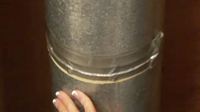
Check for loose ducts in the walls and ceilings.
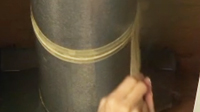
Remove the current faster at the duct seams.
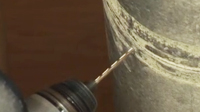
Drills a pilot hole and insert sheet metal screws. Several in each seam is recommended.
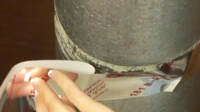
Wrap the duct seams with aluminum tape. Mastic, a paste-like substance, can also be used instead of tape.
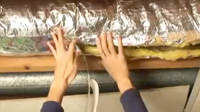
Wrap a fiberglass insulation jacket around the duct. Seal at the seams with aluminum tape.
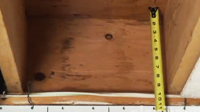
Seal rim joists (or band joists). First, measure the dimensions.
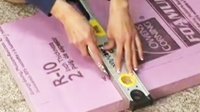
Cut the rigid foam insulation to the size slightly smaller from the dimensions you measured.
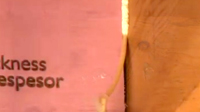
Push the foam into place and seal the edges with expanding spray foam sealant or caulk.
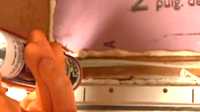
Caulk the space between the seal plate and the foundation wall.
Don’t mount it too close to where a fire is likely to occur. For example, don’t keep it next to the stove. A good place is at the top of the... More »
It all depends on personal preference. As a rule, wider moldings make a room look smaller. You may want to avoid wide moldings unless you have large... More »
If you have a gas or oil furnace, dryer, refrigerator, water heater, space heater, fireplace, wood stove or gas range, then you need to be... More »
Child-resistant locks on cabinets, electrical outlet covers, additional smoke alarms and gun locks are some of the products you should... More »
Child resistant locks on cabinets, electrical outlet covers, additional smoke alarms and gun locks are some of the products you should... More »
There are a variety of other trim options that can add a lot of detail to the entranceway. Options include caps or headers over the door, pilasters,... More »
Yes. Clay and concrete tile manufacturers offer many options of style and color of... More »
Yes, you can replace your regular outlets with ground fault interrupters. If you do not want to rewire the outlet, you can use a portable model... More »
It is not advisable. Pressure washers should only be used for removing dirt, mildew and algae that can lead to premature paint failure. Flaking... More »
Insulation must be installed with the vapor barrier facing up. This means the paper flanges cannot be used. Use insulation supports (thin metal... More »
In this final segment of our 3-part home weatherization series, we’ll be up in the attic preparing to add a layer of insulation. But before we... More »
In this first segment of our 3-part home weatherization series, we’re going to focus on areas of the house most prone to air infiltration. We’re... More »
According to the National Fire Protection Association, each year approximately 400,000 house fires are reported. What’s most alarming is that... More »